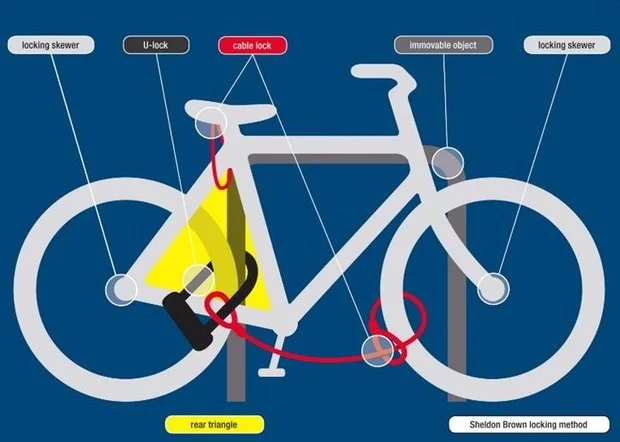Register your bike today at Bike Index!
Bike Index has partnered with the Edmonton Police Service. You can get free, tamper-resistant Bike Index registration stickers at either of our community workshops.
EPS also provides more information about bike theft here, as well as an excellent brochure which includes information about avoiding purchasing a stolen bike.
Preventing your bike from being stolen
Please remember that registering your serial number doesn’t prevent bike theft, but good locking technique can. Always keep your bike locked when you’re not physically with it: especially at home.
Use a U-lock, folding lock, or a heavy-duty security bicycle or motorbike chain (with hardened-steel links at least 10mm thick) with a heavy duty lock (a normal padlock is easy to cut), or use a U-lock in combination with a cable lock.
Do not use just a cable lock or chain from a hardware store: hand-held cutters will cut through most cheap cable locks, and even very expensive cable locks can be cut more easily than a good U-lock. Thicker cable locks may just take 3 snips instead of 1 snip: they’re not enough to protect your bike.
Better locks will have independent ratings (Sold Secure and/or ART): aim for at least Sold Secure Silver/ART 2 for medium security, but Sold Secure Gold or ART 3+ for higher-value bikes or locking outdoors, especially in less secure areas or for longer periods (more than a few minutes). Cable locks, no matter how expensive, never achieve those ratings, as, while they’re convenient, they’re also inherently weak. A $50 cable lock is guaranteed to be less secure than a $30 U-lock. Bronze ratings indicate a weak lock; no ratings mean the manufacturer hasn’t had their lock tested.
Most bikes are stolen from backyards, parkades, and out of garages or sheds. Some are even stolen from second-floor balconies. When your bike is at home, keep it locked, and out of view from potential thieves.
If your bike has a quick-release seat, either always take your seat with you (even at home), or change it to use an allen bolt.
If your bike has quick-release wheels, make sure that they are also locked up. Use your U-lock so that it passes through the frame and one your wheels (or both, if you take one wheel off). A bike with no wheels isn’t much better than a stolen bike.
Non-quick-release components can still be stolen relatively easily if left unlocked, but are slightly less likely to be stolen as quickly.
Always lock to something secure. If you lock to a branch, a post that isn’t bolted properly to the ground, a broken or unsecured bike rack, or to something that a thief can lift the lock over, the thief won’t have to break your lock to steal your bike.
Take with you any easily-removed accessories and components such as lights, seat bags, and quick-release seat.
To reduce the risk of becoming a target, never tempt thieves by leaving your bicycle locked for long periods such as overnight, or securing it in a predictable fashion, such as putting it in the same bicycle rack every day.
Mark your bicycle so that you can easily prove it’s yours, and take photos. Always record the serial number.
Is this bike stolen?
What should you do when you find an abandoned bicycle?
Thieves will sometimes make multiple trips in a night to steal multiple bikes, dumping them nearby until they can retrieve them later. If a bike suddenly appears near you, abandoned and with no owner around, you should immediately bring it some place secure. You can check to see if it’s been reported as stolen (see below), but if you find nothing, you can take it in to your nearest police station.
Is the price too good to be honest?
For a rough estimate, you can check https://www.bicyclebluebook.com/ to ballpark the used value of a bike, but keep in mind that even legitimate sellers may not necessarily always know the value of their own bike, especially lower-end or vintage bikes. For higher-end bikes, however, expect that a legitimate owner will know its value, understand its components, and be able to discuss specifics. A listing of a high-value bike for far less than it’s worth, where the seller doesn’t know or misspells the bike’s make, model, or components, is highly suspect. You can ask the seller for a photo of the bike’s serial number, but if it is actually stolen, the seller may simply ignore your or delete the listing, which can make recovery more difficult.
You can’t own a stolen bike
It is a criminal offence to be in possession of stolen property, if you know (or should have known) that the item was obtained by theft. If you purchase a stolen bike, at a minimum, if the proper owner of the bike spots it and claims it, the police may seize it from you to return to the owner, and you will receive no compensation for any money you paid to the thief.
Check the National Police Database
You can check CPIC, the police national database, to see if a serial number on a bike has been reported as stolen. To locate the serial number on a bike frame, click here.
Check Bike Index and Project 529
CPIC only records serial numbers (and then only for a small window of time between when police enter the data from a report into the database and when older database entries are purged), but the online bike registries Bike Index and Project 529 record much more info, even for bikes without recorded serial numbers.
Check to see if a bike has been reported by searching on Bike Index. Searching Bike Index will also simultaneously search the Project 529 database, so you don’t need to check them separately. (Bike Index is overwhelmingly the database used in Alberta for bicycle registration.)
Reporting and Recovering a Stolen Bike
Report to Edmonton Police Service
If your bicycle has been stolen, and you hope to recover it from the police, you must file a report with the Edmonton Police Service online.
You must be able to provide them with an exact description of the bike, including its serial number, for your best chance to recover it. If you don’t have a serial number, it can be challenging to identify your bike and prove your ownership.
You must report your bike lost or stolen to the police. It is advisable that you record and report the serial number to aid in the potential recovery of the bike. The better the description you can provide the better the chance of recovery/identification.
Report to Campus Security
If your bike has been stolen on a campus, report it to the campus security services as well, as they can access campus security footage.
Police recover thousands of bikes a year, and run serial number matches against bikes reported stolen. If they find yours, and you’ve reported your bike stolen and provided a serial number, they’ll contact you. Otherwise, your bike will end up going to auction.
We hope not to ever see you visit this page to report your bicycle stolen. Prevention is always best–emotionally and financially–so lock your bike right!
Reporting to the Public
Reporting to EPS is important, but does not create a publicly shareable notice. To help people search for your bike and avoid buying stolen property, you should report it to Bike Index and/or Project 529. Both offer free online bike registry services. We recommend Bike Index, as it is open source and non-profit, and when a person searches for bikes on Project 529, any bikes registered on Bike Index will also appear in their search results. The reverse is not true: a person searching Bike Index will not see a bike registered only at Project 529.
When you report your bike as stolen on Bike Index, our local Twitter account @stolenbikesyeg will also automatically tweet the photos and info for your bike to the #yegbike hashtag to alert the community.
Sharing on Facebook
Share your bicycle details on Stolen Bikes Edmonton Facebook group.
Places to search for your stolen bike
The Stolen Bikes Edmonton Facebook group includes many people watching out for suspicious used bike listings.
Letgo is a popular app for thieves to sell bikes
If you find your bike listed on any online classified, avoid contacting the seller or reporting the listing as stolen, as these actions can spook the thief and cause them to hide. Rather, take screenshots, record all the seller’s information, including contact info and other items for sale, and contact the police with your original police report file number to let them know. Their online fraud unit will assist in recovering your bike.
Area pawn shops. Pawn shops are required by law to check the serial numbers of any goods they receive against the CPIC database. If there was a mistake in recording the serial number, or the wrong number was accidentally identified and search, or you weren’t able to report the serial number to the police, a pawn shop could honestly miss flagging the bike as stolen. If that is the case, if you find the bike in the pawn shop and can demonstrate ownership of the bike to the police, you are entitled to the bike, without having to pay the pawn shop.
Viewing Police Recovered Bicycles
If you have a good description of the bicycle, you can contact EPS to check if the bike has been recovered. Call the Property & Exhibits Unit at 780-421-2158 and EPS staff will check to see if your bike is in their inventory. The facility is a secure facility, meaning access to the general public is not permitted. If you have reported/know a complete detailed description of your bike, there is no need to attend as EPS staff can query their database using a variety of methods. At very least you should be able to provide the make, model, distinguishing marks/engravings (distinguishable meaning unique to that individual bike, not a group of bikes).
Police Bicycle Auctions
Police bike auctions are last resort to find your bike (or simply find a replacement).
Bikes that have been recovered by the Edmonton Police, but haven’t been claimed, end up at police auctions.
Bicycle auctions are held at Michener Allen Auctioneering, 11130 Bevington Rd, Acheson, AB (outside of Edmonton). Information on dates/times of auctions/viewing can be obtained by calling Michener Allen Auctions directly at 780-470-5584.
View details online on the Michener Allen Auctions website.






